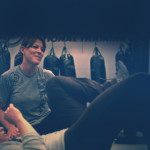Kerry Kirk: I want to focus a little bit more on you at this point. I wanted to know how you decided to go into law.
Darren Levine: I went to law school, but I never planned on practicing law. Here’s what happened. I was placed under contract with the Illinois State Police. I believe it was 1986. I had trained under Imi for 5 years—and by the way— Imi came to the training with the Illinois State Police. We trained the governor’s (James Thompson) bodyguards.
The director of the Illinois State Police was the former U.S. Attorney for that district and his name was Jeremy Margolis. Imi said this system must be given to law enforcement, this is going to save lives and he said Darren, you have a special opportunity as an attorney. If you were a prosecutor, you would have more credibility. If you are familiar with the use of force issues that law enforcement faces, people will be willing to bring this system into their departments.
Originally I had no plans on being a prosecutor. I had some high level government people encouraging me pursue a career as a prosecutor. After I passed the bar, I had letters of recommendation from the governor (of Illinois) and the director of Illinois State Police and a contact who had been an assistant director of the FBI.
The truth is, the skills developed teaching Krav Maga made me an effective DA in the courtroom. The same logical principles that Imi taught me, the same ability to reach people’s emotions, and to be logical is why I had so much success as a prosecutor. All my success was not due to a law school education. It was from what I learned in Krav Maga.
K: Is that what led you to develop the LEO curriculum for Krav Maga?
D: Yes, but it was a culmination of things. I worked first (in Israel) with Eli Avikzar, who was a Sergeant Major in the Israeli Army. I worked with the General in charge of training for the Army and then began as Superintendent of Training for the National Police.
Then I started working with other people in the US who I respect including Steve Martinez, Mike Davis, Richard Grillat, and others who had been immensely helpful. My job in law enforcement is to fully understand what a police officers’ job entails. I have seen police officers die on the street. I handle their cases from the moment they were murdered–working the crime scene–all the way to the courtroom when I am prosecuting the case (often years later).
I understand where police officers fail. I understand how criminals exploit their weaknesses. I understand the criminal mindset. I understand exactly where and how police officers need to be trained. I don’t want to come across as arrogant, but I don’t know if there is another person in the country or the world that has a combination skill sets–who can so closely examine both sides of a conflict. With my Krav Maga training and with prosecuting murders of police officers (and serious assaults on police officers) – I am uniquely qualified to do this work. I collaborate with the world’s top criminal psychologists, with the world’s top psycho-pharmacologists, with the world’s top motor skills and healing dynamic engineers, and so on.
K: You must have learned a lot with your access to expert witness in all of these fields. Then you are able to take all of this experience from so many sources– like surveillance video and eye witness testimony–that truly depicts the anatomy of a violent encounter and use that knowledge to develop a LEO curriculum.
D: I’ve spent about 16 years prosecuting cases involving serious assaults on police officers, and I have gotten to know many police officers very well. And I work closely with SWAT captains. It has put me in a very unique position to be able understand and develop a system that’s both effective and legally supportive.
K: Right. It’s a perfect marriage of your careers.
D: Yes. It’s why I feel like I have been blessed – as I have two careers, I am absolutely passionate about. When you look at the fundamental core–if I can say if I’ve devoted my life to one thing, it would be to public safety…to making people safe.
K: I wanted to ask you about some of your training with special operations groups in the U.S. and abroad. Are there any stories that you are able and willing to share? Anything that stands out?
D: We do train these groups differently. These people are selected to be members of elite units of the United States military or other forces. They are selected because of how they can process information–physically, intellectually and emotionally. These guys make the cut, because they can cope with receiving information under so much physical stress without it adversely affecting their performance.
I can take a talented group of civilian athletes and teach them curriculum that may ordinarily take a month for them to achieve a certain proficiency level, but with these special ops groups, you can have them reach the same skill level in two days – something that would take another person 30 days. I love teaching these guys because they can absorb a ton of information, and they receive it so well. They can immediately understand and appreciate the ‘how’ and ‘why’.
It is extremely rewarding. They look at it all from a different perspective than a civilian. They don’t learn a technique and get excited because they can use a new defense against someone. Rather, they see we have a technique that defeats something they are doing.
I know when it happens–when I do a live demo and they’re all looking at each other like holy shit. It’s not because they just want to learn the system. It’s because they realize that protocol can easily be defeated, so they must modify what they do. That is very interesting to them.
I love when I see people we train on the national news – those people guarding people the President of the United States or the top generals that are sent to Iraq or Afghanistan – people who are guarding the top U.S. representatives in a war zone. They’re people who I have trained or we (Krav Maga Worldwide) trained, many of whom we are in touch with by email or phone. It makes me very proud, because I know Imi would be proud.
K: Yes. That’s a perfect quote. Thank you.
D: One other thing, if I can. The nicest compliments we get are pictures from Special Forces who are in Saddam Hussein’s palace posing with the huge portrait of Saddam Hussein and wearing their Krav Maga Worldwide shirts they took with them.
People that have been involved in various high profile missions or super low profile operations, but highly important missions write us and say thank you for giving us these skills. They know it’s needed, and these skills are helping them get home to family. That’s what it’s about.
K: That’s incredible that you’re fulfilling exactly your mission in that regard. Yeah, I bet that is makes it all worth it.
D: Yeah.
K: We’re at about an hour and seventeen minutes. I understand that you have some things on your calendar to do today. Do you have time for another question?
D: I do.
K: We want to know what you are working on now—what is in the Krav Maga pipeline?
D: I am working on a lot of new teaching methods that I think will make a huge difference for people. I am definitely looking at what hard-core gangsters or serious, violent offenders are doing in prison to train against police. I’m constantly looking at how police officers are attacked. I am constantly studying how people are robbed, kidnapped, taken hostage, raped, abducted – I look at home invasion robberies, on and on. The courses that I am coming up with now are not based on what’s in the news cycle. I’m developing these things to defeat the bad guys.
K: Are you hearing much about the lone wolf attacks?
D: Yeah, in particular I want people to understand the mindset of the attackers and how that demands us to adjust our mindset.
K: I am just researching an article about that. You have to accept that there are people in the world who seek to do you harm. If you walk out of your door thinking anything else, then that makes you a much more susceptible target.
D: Yeah exactly—the world is changing. There is a significant lag time (reaction time) by people who are adjusting their level of awareness and sensibilities and tactics to meet the emerging demands. I am developing a lecture to address this specifically. I am really proud of some of the things I am working on for the future.
K: Are those publicly available? Do you ever blog about anything or is it too confidential? How do people contact you and follow you for what would be publicly available? How do people stay informed about that?
D: Train with Krav Maga Worldwide is the first priority. You know, one of the things that I am looking forward to doing in 2015 is teaching, and I know that it’s better if I reach 200 instructors at a time (than if I reach, you know, only 2 at a time). I am just trying to do what’s best to reach the most people. I love meeting students around the country. I love seeing Imi’s training essentially come to life in others, and I love encouraging people and giving them my insight and my skills.
Hopefully, I can still transfer knowledge to them. Here’s what Imi did for me. Imi used to say to me all the time, I’m not kidding, he used to say to me you can’t be good at Krav Maga until you do really understand and really care for people – until then, you can’t really explain what Krav Maga is to people.
Krav Maga is like a huge mansion. You think you’ve been in every room in a house, representing the techniques and applications of the system. Then, you open one more door and behind that door is a hallway with 10 more doors. Imi was like that – layers and layers of understanding that can only be uncovered through critical thinking and practice.
In essence, what Imi was saying, is that Krav Maga is always changing and evolving and once you think you know it all, you don’t. Instead, there’s a new door with a new problem that needs solving – utilizing the principles of Krav Maga.
You may think you know handgun defenses and you might think you know knife defenses, but do you really understand these things if you open a new door? What if an active attacker is waiting there ready to take you? It could be an active stabber. It can be an active ax wielder. My point is… that you think you know the mansion that is Krav Maga. But there are many more doors to open.
What I want to do for students and teachers alike – from around the country – is to reinvigorate them with new applications of Krav Maga. I’d like to make what they’re doing with Krav Maga better and help them with their teaching and passion for the system.
– Look for Part 3 of the Darren Levine interview in April!
Read our Darren Levine Interview: Part 1




